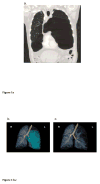A new diagnosis of Williams-Beuren syndrome in a 49-year-old man with severe bullous emphysema
- PMID: 28574231
- PMCID: PMC5509496
- DOI: 10.1002/ajmg.a.38289
A new diagnosis of Williams-Beuren syndrome in a 49-year-old man with severe bullous emphysema
Abstract
Williams-Beuren syndrome (WBS) is a chromosomal microdeletion syndrome typically presenting with intellectual disability, a unique personality, a characteristic facial appearance, and cardiovascular disease. Several clinical features of WBS are thought to be due to haploinsufficiency of elastin (ELN), as the ELN locus is included within the WBS critical region at 7q11.23. Emphysema, a disease attributed to destruction of pulmonary elastic fibers, has been reported in patients without WBS who have pathogenic variants in ELN but only once (in one patient) in WBS. Here we report a second adult WBS patient with emphysema where the diagnosis of WBS was established subsequent to the discovery of severe bullous emphysema. Haploinsufficiency of ELN likely contributed to this pulmonary manifestation of WBS. This case emphasizes the contribution of rare genetic variation in cases of severe emphysema and provides further evidence that emphysema should be considered in patients with WBS who have respiratory symptoms, as it may be under-recognized in this patient population.
Keywords: Williams-Beuren syndrome; elastin; emphysema; intellectual disability.
© 2017 Wiley Periodicals, Inc.
Figures



Similar articles
-
Pulmonary function and emphysema in Williams-Beuren syndrome.Am J Med Genet A. 2010 Mar;152A(3):653-6. doi: 10.1002/ajmg.a.33300. Am J Med Genet A. 2010. PMID: 20186780 Free PMC article.
-
Atypical 7q11.23 deletions excluding ELN gene result in Williams-Beuren syndrome craniofacial features and neurocognitive profile.Am J Med Genet A. 2021 Jan;185(1):242-249. doi: 10.1002/ajmg.a.61937. Epub 2020 Oct 24. Am J Med Genet A. 2021. PMID: 33098373
-
Assessment of clinical scoring systems for the diagnosis of Williams-Beuren syndrome.Genet Mol Res. 2013 Sep 4;12(3):3407-11. doi: 10.4238/2013.September.4.7. Genet Mol Res. 2013. PMID: 24065682
-
Growth assessment in children with Williams-Beuren syndrome: a systematic review.J Appl Genet. 2020 May;61(2):205-212. doi: 10.1007/s13353-020-00551-x. Epub 2020 Mar 10. J Appl Genet. 2020. PMID: 32157657
-
Mechanisms and treatment of cardiovascular disease in Williams-Beuren syndrome.J Clin Invest. 2008 May;118(5):1606-15. doi: 10.1172/JCI35309. J Clin Invest. 2008. PMID: 18452001 Free PMC article. Review.
Cited by
-
Airflow Obstruction in Adults with Williams Syndrome and Mice with Elastin Insufficiency.Diagnostics (Basel). 2022 Jun 10;12(6):1438. doi: 10.3390/diagnostics12061438. Diagnostics (Basel). 2022. PMID: 35741248 Free PMC article.
-
Vanishing lung syndrome: a consequence of mixed tobacco and marijuana use.BMJ Case Rep. 2021 May 20;14(5):e239255. doi: 10.1136/bcr-2020-239255. BMJ Case Rep. 2021. PMID: 34016626 Free PMC article.
-
Elastin-driven genetic diseases.Matrix Biol. 2018 Oct;71-72:144-160. doi: 10.1016/j.matbio.2018.02.021. Epub 2018 Feb 28. Matrix Biol. 2018. PMID: 29501665 Free PMC article. Review.
-
The future is here: Integrating genetics into the pediatric pulmonary clinic.Pediatr Pulmonol. 2020 Jul;55(7):1810-1818. doi: 10.1002/ppul.24723. Pediatr Pulmonol. 2020. PMID: 32533912 Free PMC article. Review.
-
Emerging mechanisms of elastin transcriptional regulation.Am J Physiol Cell Physiol. 2022 Sep 1;323(3):C666-C677. doi: 10.1152/ajpcell.00228.2022. Epub 2022 Jul 11. Am J Physiol Cell Physiol. 2022. PMID: 35816641 Free PMC article. Review.
References
-
- Beuren AJ, Apitz J, Harmjanz D. Supravalvular Aortic Stenosis in Association with Mental Retardation and a Certain Facial Appearance. Circulation. 1962;26:1235–1240. - PubMed
-
- Boueiz A, Lutz SM, Cho MH, Hersh CP, Bowler RP, Washko GR, Halper-Stromberg E, Bakke P, Gulsvik A, Laird NM, Beaty TH, Coxson HO, Crapo JD, Silverman EK, Castaldi PJ, DeMeo DL for COPDGene and ECLIPSE investigators. Genome-Wide Association Study of the Genetic Determinants of Emphysema Distribution. Am J Respir Crit Care Med 2016 - PMC - PubMed
-
- Callewaert B, Renard M, Hucthagowder V, Albrecht B, Hausser I, Blair E, Dias C, Albino A, Wachi H, Sato F, Mecham RP, Loeys B, Coucke PJ, De Paepe A, Urban Z. New Insights into the Pathogenesis of Autosomal Dominant Cutis Laxa with Report of Five ELN Mutations. Hum Mutat. 2011;32:445. - PMC - PubMed
-
- Cherniske EM, Carpenter TO, Klaiman C, Young E, Bregman J, Insogna K, Schultz RT, Pober BR. Multisystem Study of 20 Older Adults with Williams Syndrome. Am J Med Gen Part A. 2004;131:255–264. - PubMed
Publication types
MeSH terms
Substances
Grants and funding
LinkOut - more resources
Full Text Sources
Other Literature Sources

